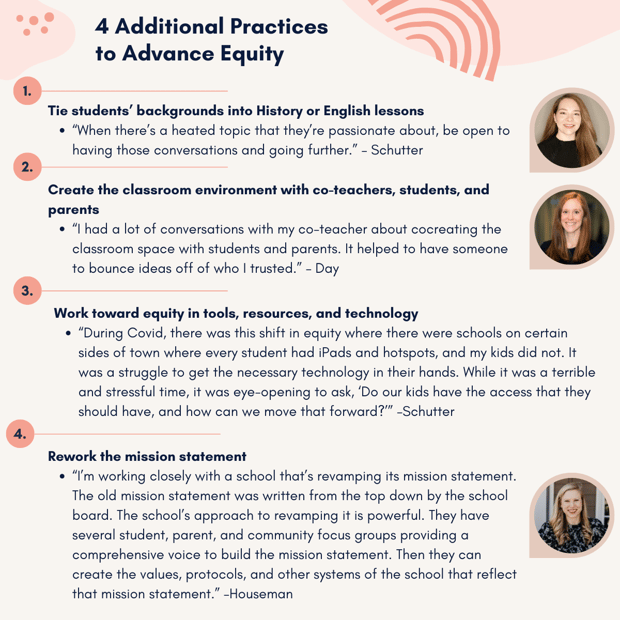For Educators By Educators: Advancing Equity in Your Classrooms
%20(11).png)
Advancing Equity in Your Classrooms
As educators, our goal is to care for and support each child equally in all facets of school and life. That said, advancing equity is a broad concept with a host of applications within the school community, so we brought together Riverside Insights’ own Jaimee Doucette, Lela Day, Anna Houseman, and Yara Nicole Schutter to lend their classroom expertise and give some shape to the idea.
First, we’ll turn to a definition from the National Equity Project: “Educational equity means that each child receives what they need to develop to their full academic and social potential.”
.png?width=117&name=FEBE%20Speaker%20Bubble%20-%20Alison%20(3).png) As Houseman notes, “That involves the right instruction to meet their needs, social-emotional support, the right curriculums, the right types and modalities of learning, and the right environment in the classroom. All of these different systems, processes, and touchpoints with a student feed in and provide that true, personalized learning experience to meet that specific child’s needs.”
As Houseman notes, “That involves the right instruction to meet their needs, social-emotional support, the right curriculums, the right types and modalities of learning, and the right environment in the classroom. All of these different systems, processes, and touchpoints with a student feed in and provide that true, personalized learning experience to meet that specific child’s needs.”
.png?width=120&name=FEBE%20Speaker%20Bubble%20-%20Alison%20(8).png) The number of factors involved is daunting, and it’s tough to know how to go about it, exactly. A point of gravity in that process, Schutter suggests, can be the relationships with your students: “One of the best things I did to ensure equity was to develop personal relationships with the students and understand all the things they’re going through.”
The number of factors involved is daunting, and it’s tough to know how to go about it, exactly. A point of gravity in that process, Schutter suggests, can be the relationships with your students: “One of the best things I did to ensure equity was to develop personal relationships with the students and understand all the things they’re going through.”
She goes on to share an example: “When the pandemic hit, one of my best students just didn’t attend any of the Zoom classes, and instead of penalizing her, I called her up. Well, the time I had my class was the same time her three younger siblings also had class, and she was the parent, essentially, of these three kids.
I told her, ‘Let me work with you so that we can figure this out, and you won’t stop learning.’ If you don’t have those relationships or you’re not meeting kids where they’re at, you’re not able to provide them with the support they need. Know what they’re dealing with so that you can bring compassion to the table.”
 Our panelists also harped on allocating time for deliberate conversations throughout the year. Doucette says, “Get that sacred time with just the adults in the building to really do some self-reflection and figure out what biases you’re bringing to the building. We all have a past and we all bring with us what we’ve learned, whether it’s purposeful or not. I think everyone who becomes an educator has excellent intentions, but that is not always the impact.”
Our panelists also harped on allocating time for deliberate conversations throughout the year. Doucette says, “Get that sacred time with just the adults in the building to really do some self-reflection and figure out what biases you’re bringing to the building. We all have a past and we all bring with us what we’ve learned, whether it’s purposeful or not. I think everyone who becomes an educator has excellent intentions, but that is not always the impact.”
.png?width=118&name=FEBE%20Speaker%20Bubble%20-%20Rhonni%20(3).png) However, don’t have one group exercise, check that box, and move on. As Day says, “Equity should be an ongoing conversation that’s weaved into the content, discipline, and school operations conversations. All of those conversations and meetings can benefit from a lens of equity.”
However, don’t have one group exercise, check that box, and move on. As Day says, “Equity should be an ongoing conversation that’s weaved into the content, discipline, and school operations conversations. All of those conversations and meetings can benefit from a lens of equity.”

Thanks for joining us in our summer webinar series, For Educators, By Educators, (FEBE), as we highlighted best practices and tactical tips our educators have found successful.
%20(4).png?width=900&name=NEW%20Addressing%20External%20Influences%20FEBE%20(2240%20%C3%97%201260%20px)%20(4).png)
.png?width=900&name=NEW%20Addressing%20External%20Influences%20FEBE%20(2).png)
.png?width=900&name=ESGI%20Survey%20What%20are%20Some%20Early%20Chilhood%20Educators%20Reporting%20(2).png)
-1.png)